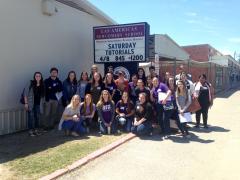
Stephen F. Austin State University students discovered what it was like to be an English language learner, immigrant and refugee student during an immersive trip to Las Americas Middle School in Houston with Dr. Mary Catherine Breen, associate professor of secondary education and educational leadership at SFA.
For a day, Stephen F. Austin State University students discovered what it was like being an English language learner, immigrant and refugee student during an immersive trip to Las Americas Middle School in Houston.
“I stepped into the students’ shoes,” said John Singleton, SFA junior music education major from Houston. “The teacher gave us an assignment in Arabic, and being an English speaker, I didn’t know what it was. It made me think, ‘Wow, this is what immigrants and refugees go through.’ It changed my perspective on teaching in a lot of ways.”
This semester, Dr. Mary Catherine Breen, associate professor of secondary education and educational leadership at SFA, brought her students enrolled in a disciplinary literacy course to Las Americas Middle School to learn about immigrant and refugee students and their quest for English proficiency.
“This experience broadens students’ perspectives. No matter where our students teach, they will have English learners in their classrooms,” Breen said. “There are federal protections for the education of immigrant and refugee students as well as native-born English learners. It is important for our students to learn about the individual students who are afforded opportunity by these laws — not just the laws themselves.”
Las Americas Middle School is a newcomer campus that educates recent immigrant and refugee students who have no or limited English language proficiency and who often have had limited formal education in their native countries. More than 35 countries, including Afghanistan, Azerbaijan, Burma, Guatemala and Somalia, and more than 30 languages, including Hindi, Swahili, Spanish and Persian, are represented at the school.
During their visit, SFA students learn about the school and how it differentiates in language-proficiency levels. SFA students spend time in the classrooms working with students who have varying levels of language proficiency on different subjects.
“When our students meet the students at Las Americas and the teachers who serve them, it personalizes the subjects we learn in the classroom,” Breen said. “While language diversity is increasing in the East Texas region, most English learners here are native Spanish speakers. At Las Americas, there are many countries and languages represented. Our students often think you have to speak the students’ languages to teach them; this isn’t the case.”
A social worker who works exclusively with immigrant and refugee students shared her experiences. For example, the social worker has spent time overseas in refugee camps and in countries where many of Las Americas’ students are from in order to gain awareness of the students’ backgrounds. She explained how trauma affects physical, mental and cognitive development and ways she works with teachers to meet students’ needs in the classrooms.
“SFA students learn about the individual students and their experiences. I can tell them about immigrant and refugee students and teaching students who are learning English, but it becomes very real when they see a campus of more than 250 students who represent this unique population,” Breen said.
SFA students not only experienced urban education while visiting Las Americas, they also heard stories from students from all over the world about their home countries, why they left, their journey to America and their experiences here.
“Las Americas is a beautiful program. It changed my perspective of refugees,” Singleton said. “I never knew the things they go through. When they tell you their stories, you need a box of tissues because it is phenomenal. The fact that the teachers are trying to actually help the students and do all that is necessary to help them progress is beautiful.”
Breen said SFA students learn a variety of lessons while on the trip, such as different methods for teaching a student whose language they don’t share; federal, state and community resources for these students; and methods for helping students who have experienced trauma and the psychology behind how this can affect learning.



